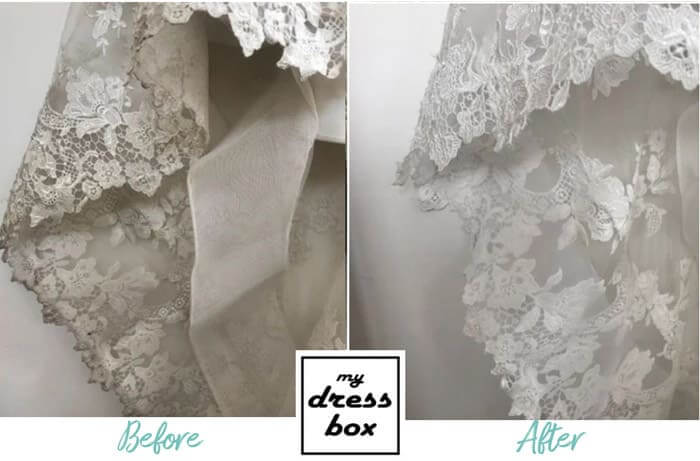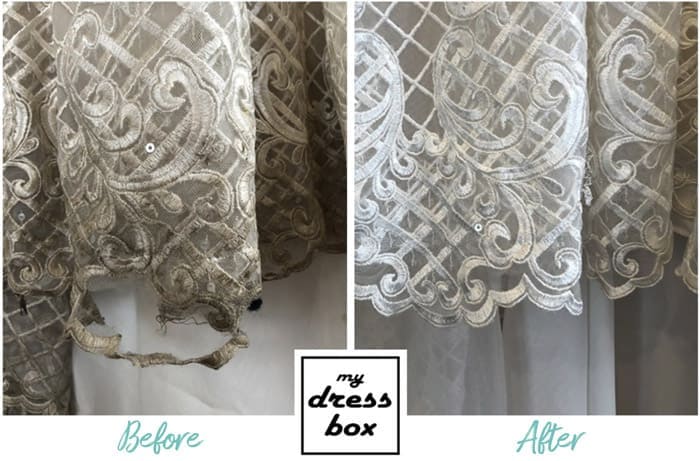How to Clean a Wedding Dress at Home
Pre-Cleaning Assessment
How to clean a wedding dress at home – Before attempting any cleaning, a thorough assessment of your wedding dress is crucial. Understanding the fabric composition and identifying stains will guide your cleaning approach and prevent further damage. Typical wedding dresses often incorporate a variety of fabrics, including delicate materials like silk, satin, lace, and tulle, alongside more durable options like organza or taffeta. The fabric composition directly influences the cleaning method; delicate fabrics require gentler treatment than more robust ones.
Common stains include wine, grass, makeup, and food spills. A systematic visual inspection will help you pinpoint the extent of the damage.
Visual Inspection Process
A systematic approach to inspecting your dress ensures no stain or damage goes unnoticed. Begin by examining the dress in good lighting, preferably natural daylight. Carefully examine each section, paying close attention to areas prone to staining, such as the train, bodice, and skirt. Note the type, location, and severity of each stain. This information will inform your cleaning strategy.
| Stain Type | Location | Severity | Initial Notes |
|---|---|---|---|
| Red Wine | Left side of skirt, near hem | Moderate | Appears slightly set-in, some discoloration visible. |
| Grass | Train | Severe | Extensive staining, appears to be deeply embedded. |
| Makeup | Shoulder area | Mild | Light smudging, easily visible. |
| Unknown | Waist | Mild | Small, light discoloration; origin unknown. |
Spot Treatment Techniques

Source: com.au
Spot treatment is essential for addressing individual stains before attempting a full wash. Different stains require different approaches. Always test any cleaning solution on an inconspicuous area first (e.g., an inside seam) to check for colorfastness and fabric reaction.
Spot Treatment Procedure
Before tackling larger stains, always test your chosen method on a small, hidden area of the dress. This prevents accidental damage to the fabric or discoloration. Follow these steps meticulously:
- Identify the stain: Determine the type of stain (e.g., wine, grass, makeup).
- Choose a cleaning solution: Select an appropriate stain remover based on the stain type and fabric composition (e.g., mild detergent, baking soda paste, specialized stain remover for delicate fabrics).
- Test the solution: Apply a small amount of the solution to an inconspicuous area and let it sit for a few minutes. Check for any discoloration or damage before proceeding.
- Apply the solution to the stain: Gently dab the solution onto the stain, working from the outside in to prevent spreading. Avoid rubbing, which can damage the fabric.
- Blot the area: Use a clean, white cloth to gently blot the area, lifting the stain. Do not rub.
- Rinse: Rinse the treated area with cool water, blotting to remove any excess solution.
- Air dry: Allow the treated area to air dry completely before assessing the results.
Handwashing the Wedding Dress
Handwashing is the safest method for cleaning most wedding dresses, especially those made from delicate fabrics. Using the correct water temperature and a gentle detergent is paramount to prevent damage and preserve the dress’s integrity.
Handwashing Guide
The following steps provide a gentle and effective method for handwashing your wedding dress:
- Fill a clean basin or tub with cool water. Add a small amount of pH-neutral detergent specifically designed for delicate fabrics.
- Submerge the dress in the water, ensuring it’s fully saturated. Avoid harsh agitation.
- Gently swish the dress in the water for a few minutes, avoiding any vigorous scrubbing or twisting.
- Drain the soapy water and refill the basin with cool, clean water. Repeat the rinsing process until all traces of soap are gone.
- Gently lift the dress from the water, avoiding any harsh squeezing or wringing. Support the dress’s weight to prevent stretching or damage.
- Roll the dress in a clean, dry towel to absorb excess water. Avoid twisting or wringing.
Drying and Storage: How To Clean A Wedding Dress At Home
Proper drying and storage are crucial for preserving your wedding dress’s condition. Avoid harsh methods that could damage the fabric or cause discoloration. Choosing the right drying technique and storage environment will protect your dress from yellowing, mildew, and other forms of deterioration.
Drying and Storage Methods
Air drying is generally the safest method for drying a wedding dress. Avoid direct sunlight or heat, which can cause discoloration and damage. Store the dress in a cool, dry, dark place, ideally in a breathable garment bag. Avoid using plastic bags, which can trap moisture and lead to mildew. Acid-free tissue paper can be used to help maintain the shape and prevent creasing.
Cleaning a wedding dress at home requires careful attention to detail; spot cleaning is often the best approach for delicate fabrics. For instance, if you’re dealing with a particularly glamorous gown, like a gold sequin dress wedding dress, extra precaution is needed. Remember to always test any cleaning solution on an inconspicuous area first before proceeding with the whole garment.
Following these steps will help preserve your beautiful dress for years to come.
Consider using a garment bag made from acid-free materials to further protect the dress from dust and light.
Addressing Specific Fabric Types
Different fabrics require different cleaning approaches. Understanding the unique properties of each fabric is crucial for effective and safe cleaning. Delicate embellishments like beads, sequins, and pearls require extra care to avoid damage.
Fabric-Specific Cleaning, How to clean a wedding dress at home

Source: com.au
| Fabric Type | Recommended Cleaning Method | Detergents to Avoid | Drying Recommendations |
|---|---|---|---|
| Silk | Handwash with a pH-neutral detergent | Harsh detergents, bleach | Air dry flat, away from direct sunlight |
| Satin | Handwash with a mild detergent | Bleach, strong detergents | Air dry flat, away from direct sunlight |
| Lace | Handwash gently, or spot clean | Harsh detergents, bleach | Air dry flat |
| Tulle | Handwash gently, or spot clean | Harsh detergents, bleach | Air dry flat |
When cleaning delicate embellishments, use a soft brush to gently remove any loose dirt or debris. Avoid harsh scrubbing or rubbing, which could damage the delicate materials. For stubborn stains, consider professional cleaning to avoid risk of damage.
Visual Guide: Before & After Cleaning
The transformation of a wedding dress after proper cleaning is significant. A stained, wrinkled, and possibly discolored dress can be restored to its original glory, or at least a very close approximation. The before-and-after comparison highlights the effectiveness of careful cleaning techniques.
Before and After Comparison

Source: theweddingshoppe.net
Before cleaning, the dress might exhibit noticeable stains, wrinkles, and possibly a dull or yellowed appearance, particularly if it has been stored improperly. The overall impression might be one of dishevelment and discoloration. After careful cleaning, the dress should appear fresh, bright, and free of stains. Wrinkles should be minimized, and the original color should be restored to its former vibrancy.
The texture of the fabric should feel soft and smooth, and the overall impression should be one of elegance and cleanliness. The transformation showcases the significant impact of proper cleaning and care.
FAQ Summary
Can I machine wash my wedding dress?
Generally, no. Machine washing is too harsh and can damage delicate fabrics. Handwashing is always recommended.
What if I have a large stain I can’t remove?
Consult a professional dry cleaner specializing in wedding gown cleaning. They have expertise and equipment for more stubborn stains.
How long does the entire cleaning process take?
The time varies depending on the dress’s condition and size. Allow ample time for each step, potentially a full day or more.
How can I prevent yellowing of my wedding dress?
Store your dress in a cool, dark, dry place, ideally in a breathable garment bag, away from direct sunlight and moisture.
















